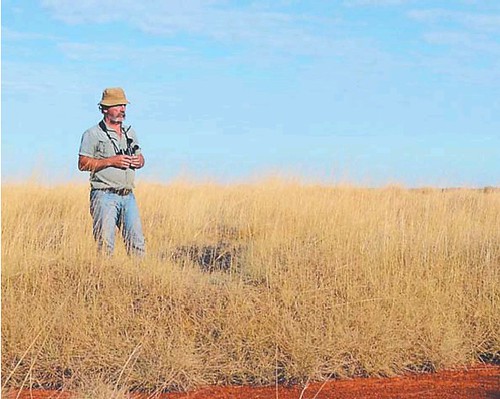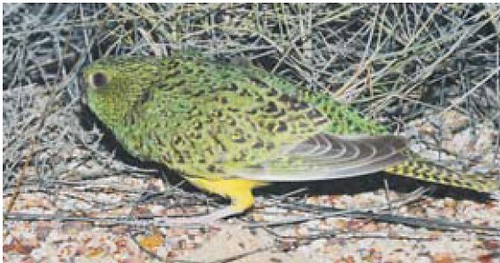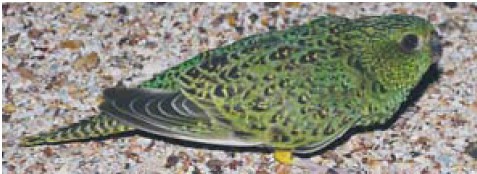Is this an authenticated sighting of a living night parrot, the holy grail of ornithology in Australia?
Fewer than 250 of the plump, greenish and black-feathered birds are thought to survive and evidence of their existence is, well, as rare as parrot’s teeth.
Next week, bushman naturalist John Young will present to the world a series of photographs and a 17-second video of a bird he watched for 35 minutes in torchlight. He will say it proves beyond doubt that he has, at last, found the elusive, mysterious night parrot.
The bird, whose habitat is outback Australia, is listed by the International Union for the Conservation of Nature as being endangered.
The most recent sighting of a live one was in 1979 at Coopers Creek in South Australia. In 2006, a headless specimen was found in the Diamantina National Park, a couple of hundred kilometres from Boulia.
Mr Young will unveil the formal evidence and photographs at a function at Queensland Museum next Wednesday. He expects to have his doubters. The 60-year-old, a wildlife filmmaker and a lifelong naturalist with a particular interest in rare birds, has regularly had his work attacked by the scientific establishment, whose main criticism is that his work does not stand up to rigorous scrutiny.
To prove the authenticity of the photographs, Mr Young and his naturalist partner Tom Biggs spoke to various scientists and last week invited an authority on the study of night parrots, Steve Murphy, a senior ecologist for the Anangu Pitjantjatjara Yankunytjatjara Land Management Unit in Kalka in South Australia, to inspect the evidence and give his opinion.
Dr Murphy, who has written extensively on the night parrot and spent years searching unsuccessfully for one, said unequivocally that the bird in the photographs and video was a night parrot.
‘‘Nothing has been as good as this find by John,’’ Dr Murphy said. ‘‘We need to establish the full extent of the distribution of this bird which could easily go extinct. In the bird world, this is the holy grail.’’
Sydney-based wildlife research scientist Rod Kavanagh is another to endorse Mr Young’s claim that the bird photographed is the night parrot.
Mr Kavanagh worked for more than 30 years at the NSW government’s forest science centre and had a special interest in nocturnal fauna and owls, and is now an ecological consultant.
‘‘I have had the photographs of this bird, a copy of the video and the voice copy of the whistle sent to me for examination and I have no doubt whatever that this is a night parrot,’’ Mr Kavanagh said.
‘‘This is a dramatic find, and I am well aware of its significance. Ask any bird-watcher and this is the bird they all nominate as the one they would most like to see.’’
Mr Young claimed to have made the find a month ago, but he spent another week in the area where he made the sighting, trying to find the bird’s nest or its partner.
 Bushman naturalist John Young, in night parrot territory, will announce his claimed finding in Brisbane next weekProtection measures had to be immediately implemented and the site secured to ensure as much as possible that the bird was not harmed and that the information did not get out, thereby attracting hundreds of interested birdwatchers to the site.
Bushman naturalist John Young, in night parrot territory, will announce his claimed finding in Brisbane next weekProtection measures had to be immediately implemented and the site secured to ensure as much as possible that the bird was not harmed and that the information did not get out, thereby attracting hundreds of interested birdwatchers to the site.
It was the recorded ‘‘whistle’’ of the bird that Mr Young said led to the find.
He said that in 2008 while he was on a search for the night parrot in far southwest Queensland, he heard a whistle just after midnight that he said had to be the sound of a parrot.
‘‘I assumed it was a night parrot and I mimicked the call and two birds responded about 500m from us and came to about 20m but we could not see them because of the high spinifex and the dark night,’’ he said.
He recorded the sound and in April 2009 and June last year succeeded in calling up a parrot but was unable to see it.
‘‘On May 24 this year I moved to a further site and at 6.28pm I put the recording on and got the loudest call from a night parrot I had ever heard,’’ Mr Young said.
‘‘On the 25th we went back to the same place and at 6.38pm a male bird called again. The next night I decided to sit in a clearing. I put my speaker on the ground and played the recordings. Within 15 seconds he came straight up to us, sat behind a tussock calling out for a few minutes and I tried the call again.
‘‘All of a sudden he was right behind us and began whistling and John put the light on and the bird arched its back and fluffed up, and began banging its head on the ground. John lifted the torch up and the parrot calmed and I got my first images.
‘‘For the next 35 minutes or so he remained in the torch light, and whenever it was taken off him, he would begin to run off. It was the most amazing experience.’’
Although Mr Young will show the images and answer any questions on Wednesday, a museum spokesman said the institution was not providing any endorsement of Mr Young’s claims, and its theatre had been hired at commercial rates by a private company.
‘‘None of the scientists at Queensland Museum have seen the pictures or endorsed the research,’’ the spokesman said. ‘‘It’s a private function.’’
In 2006, Mr Young provided pictures to Brisbane’s Courier Mail of the blue-browed f i gparrot, which he called ‘‘the Tasmanian Tiger of the bird world’’, a discovery initially endorsed by the Queensland government.
Investigations by forensic photographic expert Gale Spring, associate professor in scientific photography at Melbourne’s RMIT University and whose professional expertise extended to providing expert evidence in the case of the disappearance of British backpacker Peter Falconio, cast doubt about the authenticity of the photographs, and the Queensland government withdrew its co-operation and endorsement of the claim.
Mr Young said he had made the mistake of not keeping the film negative on that occasion.
‘‘There can be no such criticism this time as there are some 600 frames of the night parrot taken on a high-quality digital camera, and the disk is under lock and key,’’ he said.
‘‘Nobody who has seen these photographs has expressed the slightest doubt about them showing the night parrot.’’
David Sproule, an experienced photographer and computer and film-editing expert, examined the images, the computer support data and the photographs. He was able to blow the images up on a laptop screen so even one eye or one feather took up the whole screen.
He said that on the evidence he’d been given, the photographs were real.
‘‘They have not been retouched or photo-shopped in any way,’’ Mr Sproule said. ‘‘These are definitely photos taken of a colourful parrot at night, I am certain of that.
‘‘Whether or not it is a night parrot is for the experts in that field to decide, but I am convinced absolutely that they are genuine pictures.’’

